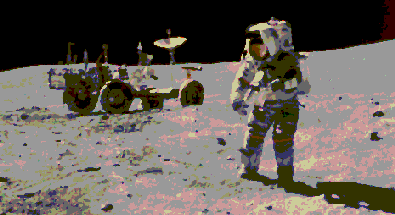
Apollo 16 (AS-511)
Landing in the Descartes highlands
The successful Apollo 16 manned lunar landing mission was the second in a series of three science-oriented J series missions planned for the Apollo program. The major objective of the mission was to investigate the lunar surface in the Descartes highlands area because it was considered to be representative of much of the Moon's surface, and an area of this type had not been previously visited.
 The Apollo 16 space vehicle was launched from the Kennedy Space Center (Launch Complex 39A) at 12:55:00 p.m. EST on April 16, 1972. The crew members for this mission were John W. Young, Commander, Thomas K. Mattingly II, Command Module Pilot, and Charles M. Duke, Jr., Lunar Module Pilot.
The Apollo 16 space vehicle was launched from the Kennedy Space Center (Launch Complex 39A) at 12:55:00 p.m. EST on April 16, 1972. The crew members for this mission were John W. Young, Commander, Thomas K. Mattingly II, Command Module Pilot, and Charles M. Duke, Jr., Lunar Module Pilot.
 The lunar module (LM) landed approximately 276 meters northwest of the planned landing site at about 104.5 hours ground elapsed time (GET). About 100 seconds of hover time remained at touchdown.
The first extravehicular activity (EVA) was initiated at 119 GET. Television coverage of surface activity was delayed until the lunar roving vehicle (LRV) systems were activated because the steerable antenna on the LM could not be used. A major part of the first EVA was devoted to establishing the nuclear powered, automatic scientific station called Apollo Lunar Surface Experiment Package (ALSEP). The duration of the first EVA was approximately 7 hours 11 minutes and a distance of 4.2 kilometers was traveled.
The second and third EVA's were devoted primarily to geological exploration and sample gathering in selected areas in the vicinity of the landing site. On the second EVA, the astronauts traveled south-southeast to a sampling area near Cinco Crater on Stone Mountain. The crew also made stops near Stubby and Wreck Craters, The duration of the second EVA was approximately 7 hours 23 minutes and a distance of 11.1 kilometers traveled.
The third and final EVA was to North Ray Crater and "House Rock", on the rim of North Ray Crater. The LRV traverse was 11.4 kilometers and lasted approximately 5 hours 40 minutes.
The lunar module (LM) landed approximately 276 meters northwest of the planned landing site at about 104.5 hours ground elapsed time (GET). About 100 seconds of hover time remained at touchdown.
The first extravehicular activity (EVA) was initiated at 119 GET. Television coverage of surface activity was delayed until the lunar roving vehicle (LRV) systems were activated because the steerable antenna on the LM could not be used. A major part of the first EVA was devoted to establishing the nuclear powered, automatic scientific station called Apollo Lunar Surface Experiment Package (ALSEP). The duration of the first EVA was approximately 7 hours 11 minutes and a distance of 4.2 kilometers was traveled.
The second and third EVA's were devoted primarily to geological exploration and sample gathering in selected areas in the vicinity of the landing site. On the second EVA, the astronauts traveled south-southeast to a sampling area near Cinco Crater on Stone Mountain. The crew also made stops near Stubby and Wreck Craters, The duration of the second EVA was approximately 7 hours 23 minutes and a distance of 11.1 kilometers traveled.
The third and final EVA was to North Ray Crater and "House Rock", on the rim of North Ray Crater. The LRV traverse was 11.4 kilometers and lasted approximately 5 hours 40 minutes.
 Total lunar surface activities lasted 20 hours 14 minutes and 95 kilograms of samples were collected. These rocks represented samples of the ancient lunar highlands. The total distance traveled in the LRV was 26.7 kilometers and the crew remained on the lunar surface 71 hours.
Entry and landing were normal. The command module was viewed on television while on the drogue parachutes and continuous coverage was provided through crew recovery. Total time for the Apollo 16 mission was 265 hours, 51 minutes and 5 seconds.
Total lunar surface activities lasted 20 hours 14 minutes and 95 kilograms of samples were collected. These rocks represented samples of the ancient lunar highlands. The total distance traveled in the LRV was 26.7 kilometers and the crew remained on the lunar surface 71 hours.
Entry and landing were normal. The command module was viewed on television while on the drogue parachutes and continuous coverage was provided through crew recovery. Total time for the Apollo 16 mission was 265 hours, 51 minutes and 5 seconds.
From NASA MSC-07230, Apollo 16 Mission Report.
 Factoids
Factoids
-
- Lunar Module - Orion ; Command and Service Module - Casper.
- Launched from Kennedy Space Center Launch Complex 39A.
- Fourth for Young (Gemini 3, Gemini X, Apollo 10,), first for Mattingly, and Duke.
- The backup crew members were Fred Haise, Jr., commander; Stuart A. Roosa, command module pilot; and Edgar D. Mitchell, lunar module pilot.
- Second mission with a lunar roving vehicle (LRV) that could transport two astronauts. The LRV could also carry tools, scientific equipment, communications gear, and lunar samples.
- First uses of the Moon as an astronomical observatory.
- Mission duration: 265 hr 51 min 5 sec.
Images from mission
Standard figures from Press Release package.
Michael J. Tuttle, June 28, 1995






 Main Apollo page
Main Apollo page